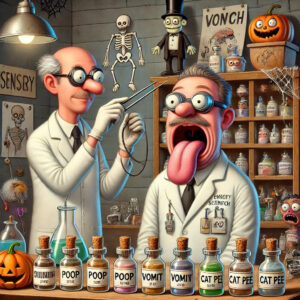Written by Michael Nestrud, Ph.D., VP of Research & Innovation at Curion.
 Welcome to the gross, spooky, slimy, shocking, and downright flatulent world of sensory research. On one eerie day this past September, we conducted not one, but two separate vomit product evaluations for different clients. Yes, you read that right—two vomit evaluations in a single day! My stomach hasn’t been the same since, but this got me thinking: it’s high time we had a little chat about the delightfully disgusting underbelly of sensory science. So, put on your lab coats, grab your nose clips, and hold onto your lunch, because things are about to get weird.
Welcome to the gross, spooky, slimy, shocking, and downright flatulent world of sensory research. On one eerie day this past September, we conducted not one, but two separate vomit product evaluations for different clients. Yes, you read that right—two vomit evaluations in a single day! My stomach hasn’t been the same since, but this got me thinking: it’s high time we had a little chat about the delightfully disgusting underbelly of sensory science. So, put on your lab coats, grab your nose clips, and hold onto your lunch, because things are about to get weird.
The Shocking World of Electrogustometry
Let me take you back to the 18th century when Italian scientist Luigi Galvani was zapping frog legs strung up on a clothesline—he accidentally discovered nerve signaling and probably gave the frogs an existential crisis. Fast forward to 2006, and there I was, on my very first day in the University sensory science lab, invited to join a taste test involving electricity. Yes, folks, “what does electricity taste like?” was the question of the day. Picture this: electrodes and batteries glued to tongue depressors, a bit of mad scientist flair, and voilà! We were shocking our tongues like it was a weird carnival game. This research helped the world understand perception, but I still haven’t quite come to terms with how my taste buds spent their rookie season.
Vials of Vile Odors
You probably have a couple of perfume bottles at home, right? Maybe something that smells like a summer breeze or fresh flowers. Well, we’ve got something a little different: welcome to our malodor library, where you can sniff something far worse than last week’s gym socks. Need the scent of poop, vomit, or—oh, why not—cat pee? We’ve got it all! These scientifically formulated stink bombs are used for testing products that claim to eliminate odors, and yes, that includes the smell of a dog that’s been rolling in mystery goo at the park. So, next time you spray that bathroom air freshener, just remember: somewhere in a lab, there’s a vial labeled “Cat Pee – Harvested” that’s been sniffed for science.
An Armpit By Any Other Name Would Smell as... Sweaty?
Speaking of stinks, did you know that describing body odor is practically an art form in the world of sensory science? Move over wine tasters, we’ve got lexicons for armpits! That’s right—just as sommeliers wax poetic about the “hints of oak and blackberry” in a Merlot, we can wax (less poetic) about the “greasy,” “fatty,” or “oily” nuances of human sweat. Somewhere out there, a brave group of people has spent way too much time sniffing armpits to make sure that your deodorant does its job. So next time you roll on some antiperspirant, give a nod to the hardworking souls who smelled hundreds of body parts to define “greasy” as “dirty scalp and hair aromas.”
A Spooky Science Indeed
In conclusion, next time you’re out shopping for deodorant, a trash bag, or cleaning up after your beloved black cat FiFi, take a moment to appreciate the mountain of gross sensory science that went into perfecting those products. From shocking tongues to sniffing armpits, we sensory scientists are out here doing the dirty work (literally) to make sure your everyday items pass the sniff test—sometimes with smells we wish we could forget.
